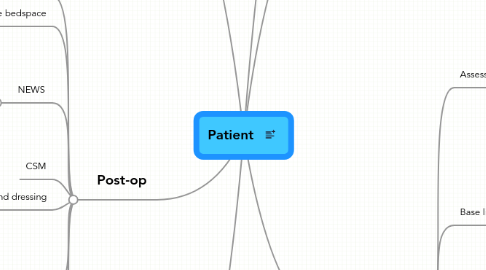
1. Patient History
1.1. Hypertension
1.1.1. Ramipril 2.5mg
1.1.1.1. well controlled
1.2. smoker
1.2.1. 15 a day
1.3. Osteoarthritis
1.3.1. ?pain management
1.3.1.1. medication
1.3.1.1.1. contra-indications?
1.3.2. mobility
1.4. alcohol
1.4.1. ?issues sleeping
1.5. social
1.5.1. housing
1.5.2. family support
2. Post-op
2.1. ABCD
2.2. Before arrival- prepare bedspace
2.3. NEWS
2.3.1. Every 15 min for 1st hour
2.3.2. Then every 30 minutes
2.3.3. Pain assessment
2.3.4. Nausea
2.4. CSM
2.5. Check wound and dressing
2.6. Risk assessment
2.6.1. MUST
2.6.2. Cannard
2.6.3. SSKIN
2.6.4. Waterlow
2.7. Pain management
2.8. Patient education
3. Post-op complication
3.1. Infection
3.1.1. Deep sternal infection
3.1.2. Superficial infections from where blood vessel was removed
3.1.3. Infection occurs 1 in every 25
3.2. Pain/tenderness at wound site
4. Risk factors
4.1. Smoking
4.1.1. 15/ day, hypoxia, wound healing issues, increase chance of MI and stroke
4.2. Age
4.2.1. Social factors
4.2.1.1. Housing on top floor, modification, OT.
4.3. Alcohol
4.3.1. Clash with meds
4.4. Hypertension
4.4.1. Ramapril,
4.4.1.1. Fluctuating BP and HR during surgery
4.5. Infection
5. Discharge
5.1. Other health professionals
5.1.1. District nurse
5.1.1.1. Dressing changes
5.1.1.2. suture removal
5.1.1.3. support/ education
5.1.2. Occupational therapist
5.1.2.1. Home assessment
5.1.3. Physio
5.1.3.1. Mobility
5.1.3.1.1. stair practice
5.1.3.1.2. maintain independence
5.1.4. GP
5.1.4.1. Post op med
5.1.5. Dietitian
5.1.5.1. If required
5.2. Checklists
5.2.1. Relevant paperwork
5.2.2. Transportation
5.2.3. Home care assessment
5.2.4. Medication
5.2.5. Discharge letter
5.3. Patient education
5.3.1. Medications
5.3.2. Smoking cessation
5.3.3. Wound awareness
6. Admission
6.1. Assessment
6.1.1. Care plan
6.1.1.1. Goal setting
6.1.2. Cannards
6.1.3. Waterlow
6.1.4. Must
6.1.5. Next of kin
6.1.6. EMT
6.1.7. ECG
6.2. Base line obs
6.2.1. BM
6.2.2. NEWs
6.3. Presenting compliants/diagnosis
6.3.1. X ray
6.3.2. MRI
6.3.3. Full Bloods
6.3.4. ECG
6.3.5. Other Investigations
6.3.6. Lung function
6.3.6.1. peak flow
6.4. Admission meds
6.5. relevant PMH
6.5.1. Smoking
6.5.1.1. Smoking cessatoin
6.5.1.2. complicatoins
6.6. Venus bloods
6.7. Sticky Labels
6.8. Social circumstance
6.8.1. Discharge planning
